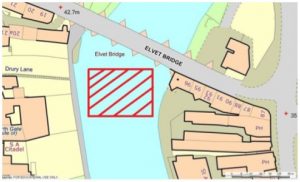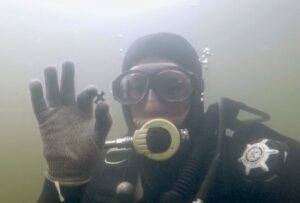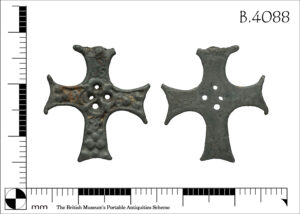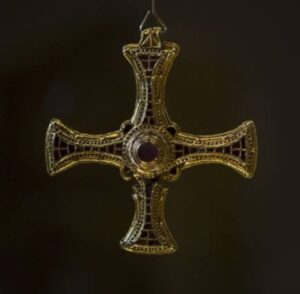March ’21
Silver Pectoral Cross
The Site

Between 2008 and 2019, archaeological investigations of a submerged river bed, positioned just downstream from the twelfth century Elvet Bridge in Durham City, County Durham, have revealed an important multi-period underwater archaeological site. This site has eventually yielded a significant collection of typically small metal finds, the total number of which now exceeds 13,000 objects.

The find site, positioned just downstream of the twelfth century Elvet Bridge in Durham City, lies mid-way between two areas of late-medieval urban development: the Borough of New Elvet and the Bishop’s Borough. The late-medieval city of Durham comprised of five boroughs, the tenements located in the Bishop’s Borough, positioned immediately to the west of the find site, were known as Saddlergate (now Saddler Street), while the tenements which abut the river to the east (in the Borough of New Elvet) were simply referred to as the western edge of New Elvet.
You can learn more about the site and the objects here: https://diveintodurham.uk/
The Object

A cast silver object in the form of a cross, with near equal length flared arms. The obverse side is decorated with a central quatrefoil and each arm features a trefoil and a grouping of three raised circles. The upper and lower arms have an additional row of three raised circles at their end. The trefoil on the upper arm is partially obscured by a smooth portion of metal, above which is an abnormality in the metal. The object was most likely cast using a stone mould made of two parts which slotted together, it is possible that the abnormality and smooth area of metal, are casting flaws and a potential cause for the object to be discarded.
The size, ‘wearability’, material, location and imagery all suggest that the object is most likely a pilgrim badge or at least some form of religious token. The object is almost certainly Christian in nature; given it is shaped as a cross, has a central quatrefoil and features trefoils on each arm, alongside clusters of three raised domes, which are both representative of the holy trinity. The quatrefoil is also associated with Christianity, representing the four gospels of Matthew, Mark, Luke and John.

Whilst the probability that this is a Christian cross is very high, the typology of the cross is another matter. The flared arms are reminiscent of St Cuthbert’s cross, found in his tomb in the 19th century and of another pilgrim badge discovered under Elvet bridge as part of the same project. This other Elvet bridge find is posited to be a St Cuthbert’s cross on the basis that it has flared arms and is decorated in the Anglo-Saxon cloisonné style, a potential imitation of the opulent garnet inlays of the cross from St Cuthbert’s tomb.
The “generalised iconography” of pilgrim badges can make it hard to establish a verifiable link between a badge and a corresponding saint or church. Some badges are indeed highly individualised, such as those of Thomas Beckett and Lady Walsingham, but many depicted much more universal Christian imagery. It is therefore prudent to be cautious about making a definitive connection between this object and St Cuthbert or any other saint, as whilst there are some similarities there are also significant differences, such as the trefoils and pierced quatrefoil.
Pilgrim badges were a significant part of material culture at the peak of the popularity of pilgrimages, it is estimated that some manufacturers could produce thousands every day and they were sold along pilgrimage routes across Europe. Pilgrim souvenirs, including badges and ampullae, were commonly attached to clothes, hats and bags by pilgrims as symbols of their pilgrim status. This acted as both a way to socially mark themselves as pilgrims and as a way to visibly display their piety and devotion.
Stay tuned for next month’s object!
